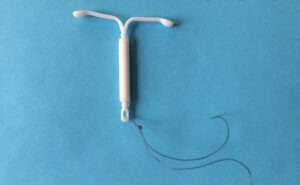Sometimes, it's hard to get your fibroids diagnosis. First of all, about 40 percent of women with uterine fibroids don't have any symptoms. Often, women with uterine fibroids do develop symptoms. These include long, heavy periods; weight gain; bloating; constipation and pelvic pain.
But what if you already experienced many of those symptoms, because you were carrying extra weight? Or because of other conditions? Or what if you just had no idea that your symptoms were anything but a normal, if unpleasant, part of being a woman? It would certainly make it harder to recognize an abnormal (but non-cancerous) tumor in your uterus. And it could help explain why up to 35% of women with these symptoms delay seeking medical help until their lives become severely disrupted!
Aside from causing needless discomfort, delays in diagnosis can result in further health concerns. Because, as your fibroids grow larger, symptoms such as heavy bleeding can grow worse, leading to anemia or even unnecessary surgery. Want to make sure that doesn't happen? Keep reading for helping with earlier symptom detection!

For one woman from Wales, that was exactly what happened. Tina Mathias, at her heaviest, weighed almost 340 pounds. She suffered from chronic back pain and constipation, but when she shared these symptoms with her doctor, they were considered a byproduct of her poor diet and excess weight.
At the time, Tina assumed her doctors were correct. "My periods were normal which is why I didn’t think it was a problem with my reproductive system," she says.
In the hopes of improving her health and alleviating her worst symptoms, Tina set out on a weight loss journey. She was extremely successful, dropping 182 pounds, but her problems didn't resolve.
“I’d lost so much weight and I thought I’d be healthier, but the pain in my lower back, sides and abdomen carried on,” she says. “Then it got so bad that I couldn’t get out of bed and I would wince if my husband touched me."
Still, Tina didn't think her problems could be caused by fibroids. She simply continued eating healthfully, trying to lose more weight and hoping to feel better.
Nkem Osian is a Nigerian American who spent months living with heavy periods. She told Verywell Health that she waited to see her doctor because, "Talking about reproductive health was always taboo. Although I knew that my mother and sisters had experienced heavy periods, it wasn't something that we ever really discussed. So when my periods started changing in my late twenties, I felt like it was just part of being female."
Sadly, like Tina, Nkem delayed seeking help for her symptoms. Even though, she says, "I was bleeding for two weeks at a time, sometimes with significant spotting in between cycles. There were many times when I would bleed through my clothes on the train from my home in New Jersey to my office in New York. It was humiliating, but what could I do? That was just my life."
Even worse? Nkem was passing large clots. And, while we tell patients that clots bigger than a quarter are a sign of concern, Nkem's were even larger. She says, "They were the size of my fist and very painful to pass." Still, she waited to see her doctor. So that, by the time she made an appointment, she was told, "You have a blood level not conducive to life."
Clearly, at that point, Nkem's doctor knew she needed help. But that's not always the case. In fact, some women feel ignored by their physicians. In fact, a recent survey from the Fibroid Foundation found that 37% of women surveyed needed to see two or three different doctors before getting a fibroid diagnosis. Even worse? 15% of the women needed to see as many as five doctors before diagnosis. And a shocking 7% saw over five doctors before finding out what was wrong. Obviously, that can delay your fibroid diagnosis. (And treatment!)

That was the case for LaToya Dwight, who also spent years living with fibroid symptoms. Every day, she faced fatigue or bloating. Some days brought painful sex, others saw cramping and constipation. But, despite seeing the same OB-GYN for 12 years, fibroids never entered the conversation. Until she went to get her IUD removed. And her doctor couldn't locate the device inside her uterus!
Sometimes, your doctor isn't at fault for a delayed diagnosis. Instead, society may be to blame. After all, too many women aren't aware of the fact that symptoms such as heavy, long periods are abnormal. And they certainly don't know much about fibroids. For that reason, our fibroid experts in Houston always take part in Fibroid Awareness campaigns. Because, in that way, we can help women reach diagnosis (and treatment) far sooner than they would otherwise.
And here's some good news worth sharing on the diagnosis front. The FDA recently approved a new 3D Modeling Device, called the Fibroid Mapping Reviewer Application. By creating a 3D rendering of the uterus, based off ultrasound images, it helps speed up diagnoses and plan appropriate courses of treatment.
For Tina, answers came when she got thin, and she had a moment that put everything into perspective.
“When I really slimmed down, my belly was still so large. I looked six months pregnant," she says. “Someone in work asked me when the baby was due and that’s when I knew something really wasn’t right.”
Still, doctors didn't immediately figure out what was ailing Tina. They attributed her constipation to a low calorie diet, and didn't think to examine her for fibroids until sex with her husband became extremely painful. Finally, she was sent for a scan, and doctors discovered a nine-pound fibroid, made of muscle and fibrous tissue, that had likely been growing in her uterus for a decade or more!
It was now dangerously close to perforating her bowel, and doctors told her she needed a life-saving hysterectomy. Just 36 at the time, Tina was devastated but, since the tumor was so large and in such a dangerous location, she had no choice. Now 43, Tina has had to give up on her dreams of having a family, but she is living a happy, healthy and pain-free life.
For LaToya, answers came in a different way. When her OB ordered an ultrasound to find the missing IUD, the technician asked her about her fibroids and symptoms. But the problem was, that was the first time anyone told her that she had these growths!
Once LaToya got back to her OB's office, the only guidance she received was to get a hysterectomy. But, unlike Tina, LaToya still had fibroid treatment options. At first, she tried lifestyle changes and eating to help her fibroids. Then, through research, she found out about UFE, and found her minimally-invasive solution.
And Nkem? Well, initially, her doctor found one large fibroid. And put her on birth control to try and manage symptoms. But she developed more fibroids. So, now, she's exploring treatment options instead of managing her symptoms. And she's part of The White Dress project, to help ease the path for other women with fibroids.
Luckily, LaToya got a happy ending. But the saddest part of this story is that, had someone diagnosed Tina's fibroid earlier on, she could have preserved her fertility. That's why its important for women to know all of the symptoms of fibroids. Its crucial to recognize that, even if your periods are normal, you may still have a problem. You also need to be your own advocate: if your pain persists and your doctor insists its because of your weight, it's not time to give up hope: it's time to get a second opinion.
Or, if your doctor tells you to get a hysterectomy, get a second opinion and do your research! Because the earlier you treat fibroids, the more options that will be available for your treatment. And please remember: we welcome all women to our Houston fibroid treatment practice for second opinion treatment consultations. So schedule your appointment today!
Sources: Dailymail, Healthline
As leading fibroid specialists in Houston, we can help you get back to doing the things you love – free of pain and symptoms associated with this diagnosis.

Scheduling
Please contact our dedicated specialists to schedule a consultation today.
2025 Houston Fibroids. All rights reserved. Website Design by Healthcare Success